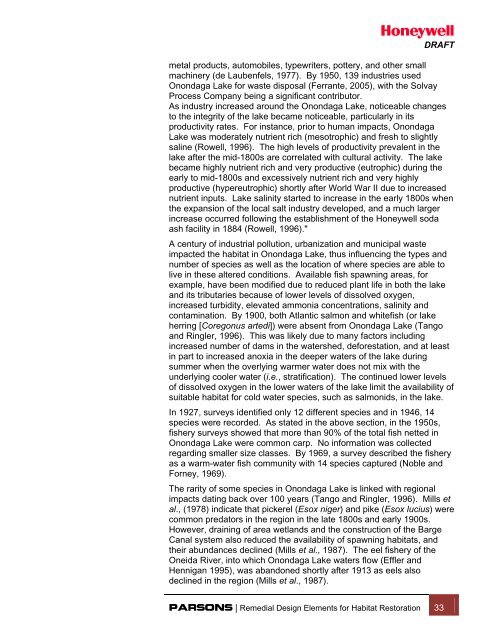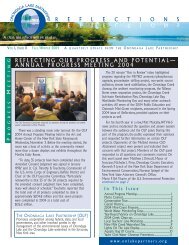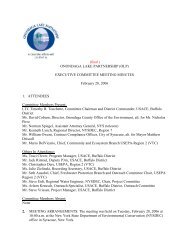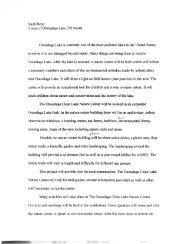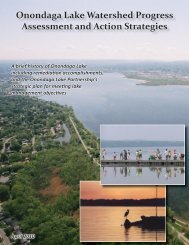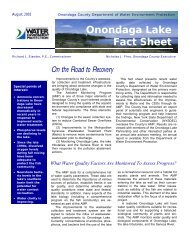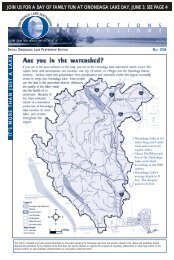Habitat Plan 2 - Onondaga Lake Partnership
Habitat Plan 2 - Onondaga Lake Partnership
Habitat Plan 2 - Onondaga Lake Partnership
You also want an ePaper? Increase the reach of your titles
YUMPU automatically turns print PDFs into web optimized ePapers that Google loves.
DRAFTmetal products, automobiles, typewriters, pottery, and other smallmachinery (de Laubenfels, 1977). By 1950, 139 industries used<strong>Onondaga</strong> <strong>Lake</strong> for waste disposal (Ferrante, 2005), with the SolvayProcess Company being a significant contributor.As industry increased around the <strong>Onondaga</strong> <strong>Lake</strong>, noticeable changesto the integrity of the lake became noticeable, particularly in itsproductivity rates. For instance, prior to human impacts, <strong>Onondaga</strong><strong>Lake</strong> was moderately nutrient rich (mesotrophic) and fresh to slightlysaline (Rowell, 1996). The high levels of productivity prevalent in thelake after the mid-1800s are correlated with cultural activity. The lakebecame highly nutrient rich and very productive (eutrophic) during theearly to mid-1800s and excessively nutrient rich and very highlyproductive (hypereutrophic) shortly after World War II due to increasednutrient inputs. <strong>Lake</strong> salinity started to increase in the early 1800s whenthe expansion of the local salt industry developed, and a much largerincrease occurred following the establishment of the Honeywell sodaash facility in 1884 (Rowell, 1996)."A century of industrial pollution, urbanization and municipal wasteimpacted the habitat in <strong>Onondaga</strong> <strong>Lake</strong>, thus influencing the types andnumber of species as well as the location of where species are able tolive in these altered conditions. Available fish spawning areas, forexample, have been modified due to reduced plant life in both the lakeand its tributaries because of lower levels of dissolved oxygen,increased turbidity, elevated ammonia concentrations, salinity andcontamination. By 1900, both Atlantic salmon and whitefish (or lakeherring [Coregonus artedi]) were absent from <strong>Onondaga</strong> <strong>Lake</strong> (Tangoand Ringler, 1996). This was likely due to many factors includingincreased number of dams in the watershed, deforestation, and at leastin part to increased anoxia in the deeper waters of the lake duringsummer when the overlying warmer water does not mix with theunderlying cooler water (i.e., stratification). The continued lower levelsof dissolved oxygen in the lower waters of the lake limit the availability ofsuitable habitat for cold water species, such as salmonids, in the lake.In 1927, surveys identified only 12 different species and in 1946, 14species were recorded. As stated in the above section, in the 1950s,fishery surveys showed that more than 90% of the total fish netted in<strong>Onondaga</strong> <strong>Lake</strong> were common carp. No information was collectedregarding smaller size classes. By 1969, a survey described the fisheryas a warm-water fish community with 14 species captured (Noble andForney, 1969).The rarity of some species in <strong>Onondaga</strong> <strong>Lake</strong> is linked with regionalimpacts dating back over 100 years (Tango and Ringler, 1996). Mills etal., (1978) indicate that pickerel (Esox niger) and pike (Esox lucius) werecommon predators in the region in the late 1800s and early 1900s.However, draining of area wetlands and the construction of the BargeCanal system also reduced the availability of spawning habitats, andtheir abundances declined (Mills et al., 1987). The eel fishery of theOneida River, into which <strong>Onondaga</strong> <strong>Lake</strong> waters flow (Effler andHennigan 1995), was abandoned shortly after 1913 as eels alsodeclined in the region (Mills et al., 1987).PARSONS | Remedial Design Elements for <strong>Habitat</strong> Restoration 33


